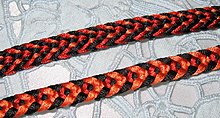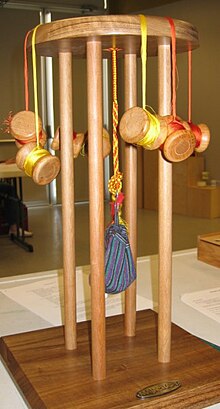This article possibly contains original research. (July 2023) |
Kumihimo (組み紐) is a traditional Japanese artform and craftwork for making braids and cords.[1][2] In the past, kumihimo decorations were used as accessories for kimono as well as samurai armor.[3] Japanese braiding, as kumihimo is sometimes known in English, is also associated with Shinto rituals and religious services.[2] Literally meaning "gathered threads", kumihimo are made by interlacing reels of yarn, commonly silk, with the use of traditional, specialised looms – either a marudai (丸台, lit. 'round stand')[2] or a takadai (高台) (also known as a kōdai).


There are a number of different styles of kumihimo weaving, which variously create a braided cord ranging from very flat to almost entirely rounded.[1] Kumihimo cords are used as obijime, cords worn belted around the front of some obi when wearing kimono.
History
editKumihimo was introduced to Japan from China via the Korean peninsula around 700 AD.[4][5] When the art first arrived in Japan, it was used to decorate Buddhist scrolls and other votive items. The city of Nara emerged as a centre of cultural and artistic exchange and became the point of introductory of kumihimo to Japan.[6]
Kumihimo braids were first created by using fingerloop braiding to weave different yarns together. Later, tools such as the marudai and the takadai were developed, allowing more complex braids to be woven in a shorter amount of time.
In the present day, modern variations of kumihimo weaving discs exist, typically made of firm, dense foam with (typically) 32 notches around the edge, creating the tension necessary for weaving kumihimo. These discs are considered to be a more affordable and portable alternative to a traditional marudai, with many different sizes and shapes of disc available for purchase.
However, a modern foam kumihimo disc is considered less versatile than a traditional marudai. A traditional marudai allows the weaver to use as many yarns of as many thicknesses as desired, and to create braids which are flat, four sided, or hollow. A foam kumihimo disc constrains the weaver to no more than 32 yarns that must not be thicker than the notch allows, and does not enable the creation of flat braids.[citation needed] To make a flat braid a separate rectangular or square "disc" must be made or purchased.
The most prominent historical use of kumihimo was by samurai, as a functional and decorative way to lace their lamellar armour and their horses' armor (barding). Kumihimo cords are now used as ties on haori jackets and as obijime, used to hold some obi knots in place or to decorate the obi when wearing kimono.
Modern kumihimo: 20th and 21st centuries
editJapanese braiding is being used in other areas in addition to its traditional uses, and has been taken up by arts and craft communities outside of Japan.[7][8] Kumihimo has gained in popularity outside of Japan, with an increasing number of beginner books available in languages other than Japanese.[9][10][11][12][13] There is also a Journal of the American Kumihimo Society.[8]
In contrast to the interest in Japanese braiding as a craft for all, the city of Columbus, Georgia, USA, commissioned Junichi Arai (1932–2017) to create a permanent 12 × 9 metre metallic fibre artwork consisting of 200 stainless steel kumihimo braidings that produced kinetic waves.[7] Arai is considered an important innovator who raised textiles from craft to art. Akiko Moriyama describes him thus: "Arai embodies everything about Japanese textiles, from the challenges to the possibilities."[7] Arai's installation opened at for the River Center for Performing Arts in 2003.[7]
Types
editThe three prominent types of kumihimo are kado-uchi himo (角打ち紐), hira-uchi himo (平打紐), and maru-uchi himo (丸打紐).[4]
Related terms
edit- Kagami – the top braiding surface on a marudai; Japanese for "mirror".
- Kongō Gumi – a class of patterns for round cord all involving eight threads folded in half for a total of sixteen strands. In clockwise order, each bobbin is moved to the opposite side. When different combinations of thread color are used, many interesting patterns emerge, including diagonal stripes, diamonds on a background, triangles resembling hearts, and tiny six-petalled flowers.
- Marudai or maru dai – the frame for the braiding; maru dai Japanese for "round stand".
- Mizuhiki, decorative cords used to decorate objects such as shūgi-bukuro envelopes.
- Obijime – the broad cloth sash used in traditional dress; a kumihimo belt, called the obijime, is tied around the obi.
- Takadai – a takadai is a large, rectangular frame for creating flat, oblique kumihimo braids.
- Tama – bobbins. The thread is kept from unwinding by passing the thread under itself, forming a loop around the tama. True silk is a hollow fiber with a rough surface that resists slipping past the loop unless gently pulled. For synthetic fibers, a flexible plastic "clamshell" bobbin may be preferable.
See also
editReferences
edit- ^ a b Kinoshita, Masako (1986). "A Braiding Technique Documented in an Early Nineteenth-Century Japanese Treatise" Soshun Bik‾"". Textile Museum Journal. 25: 47–65 – via EBSCOhost Art & Architecture Source.
- ^ a b c Kimura, Akiko; Tada, Makiko; Uozumi, Tadashi; Goto, Akihiko (2018), Trzcielinski, Stefan (ed.), "Teaching Method of Technique to Make the Braiding", Advances in Ergonomics of Manufacturing: Managing the Enterprise of the Future, vol. 606, Cham: Springer International Publishing, pp. 310–321, doi:10.1007/978-3-319-60474-9_29, ISBN 978-3-319-60473-2, retrieved 2024-07-09
- ^ Duffy, Vincent G. (2016-07-04). Digital Human Modeling: Applications in Health, Safety, Ergonomics and Risk Management: 7th International Conference, DHM 2016, Held as Part of HCI International 2016, Toronto, ON, Canada, July 17–22, 2016, Proceedings. Springer. pp. 132–133. ISBN 978-3-319-40247-5.
- ^ a b ""Kumihimo": Intricate and Highly Functional Braided Cords from Japan That Continue to Evolve in the Present Day". Web Japan. Retrieved 29 January 2024.
- ^ "Connecting the Atlantic and the Indo-Pacific | Events". JAPAN HOUSE (Los Angeles). Retrieved 2024-01-29.
- ^ "The Origins of Kumihimo: Talk by Mita Kakuyuki". Japan House London. Retrieved 2024-01-29.
- ^ a b c d Moriyama, Akiko (2020). Harris, Jennifer (ed.). Japanese Textile Culture in A Companion to Textile Culture. Wiley-Blackwell companions to art history. Hoboken, NJ: John Wiley & Sons, Inc. pp. 353–370. ISBN 978-1-118-76860-0.
- ^ a b Hardy, Beth; Benner, Carol; Haushalter-Oliver, Carolyn; Mutter, Debbie; Shirashi, Diana; Imperia, Giovanna; Pigot, Jan; Peterson, Jane; Johansen, Katia; Tada, Makiko; Jeppesen, Margaret; Tada, Masumi; Nielson, Rosalie; Berlin, Shirley; Guang, Yin (2020). Gaskell, Adrienne; Buenger, Katherine (eds.). "Gathering Threads". Journal of the North American Kumihimo Society.
- ^ Carey, Jacqui (1994). Creative Kumihimo. Ottery St. Mary: Carey Co. ISBN 978-0-9523225-0-4. OCLC 31936680.
- ^ Schwarz, Miriam; Schwarz, Roswitha, eds. (2014). Das große Kumihimo-Buch: japanische Flechtkunst; [mit 8 Schablonen für den runden Mobidai]. TOPP (4. Aufl ed.). Stuttgart: Frech. ISBN 978-3-7724-5660-2.
- ^ Kemp, Beth (2014). Twist, turn & tie: 50 Japanese kumihimo braids (First edition for North America ed.). Hauppauge, New York: Barron's Educational Series, Inc. ISBN 978-0-7641-6643-3. OCLC 872279591.
- ^ Delage-Calvet, Agnès; Boutin, Richard (2015). Bracelets kumihimo: techniques des bracelets japonais et modèles. Paris: Marabout. ISBN 978-2-501-10094-6.
- ^ Carey, Jacqui (2019). Beginner's guide to Japanese braiding: the art of kumihimo. Search Press classics. Kent, UK: Search Press Limited. ISBN 978-1-78221-805-0. OCLC 1142683213.